Rick Just's Blog, page 70
January 26, 2023
A Reluctant Idahoan (tap to read)
Most Idahoans would rather live here than anywhere else. Today’s story is about a woman who desperately wanted to stay away, yet went on to popularize Idaho in illustration and story.
Mary Hallock grew up in New York, and received her education in Boston. She socialized with the elite of New England, but she fell in love with a civil engineer named Arthur Foote who had the grit of the West beneath his fingernails.
Mary Hallock Foote came West in the nation's Centennial year, 1876, but she did not come eagerly. Mrs. Foote once wrote, "No girl ever wanted less to go West with any man, or paid a man a greater compliment by doing so."
The Foote's lived in Idaho from 1883 to 1895, mostly in the Boise River Canyon near present day Lucky Peak Dam. It was a frustrating, heartbreaking time for them, but Mary made use of her hard experience. She was an illustrator for books and magazines of the era. In fact, she was once called the dean of women illustrators.
Encouraged by an editor to write as well, she became a popular author.
Mary Hallock Foote wrote many short stories, and a dozen novels. Much of her writing was based on her years in Idaho. Coeur d'Alene, Silver City, Boise, Thousand Springs, and Craters of the Moon were all settings for her stories.
In 1971 she was the subject of an enchanting—if controversial—story herself. Wallace Stegner's Pulitzer Prize-winning novel Angle of Repose is based on the fascinating life of Mary Hallock Foote... a somewhat reluctant Idahoan.
I’m pleased to say that a new Foote Park interpretive exhibit opened not long ago. You can reach it by crossing Lucky Peak Dam and taking the first road to your right. There is a restroom on site and plenty of parking. It’s well worth a few minutes of your time.
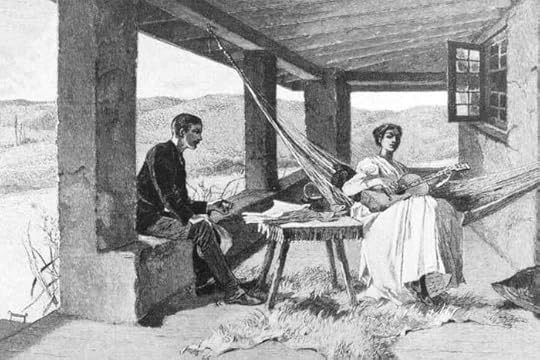 An illustration by Mary Hallock Foote.
An illustration by Mary Hallock Foote.
Mary Hallock grew up in New York, and received her education in Boston. She socialized with the elite of New England, but she fell in love with a civil engineer named Arthur Foote who had the grit of the West beneath his fingernails.
Mary Hallock Foote came West in the nation's Centennial year, 1876, but she did not come eagerly. Mrs. Foote once wrote, "No girl ever wanted less to go West with any man, or paid a man a greater compliment by doing so."
The Foote's lived in Idaho from 1883 to 1895, mostly in the Boise River Canyon near present day Lucky Peak Dam. It was a frustrating, heartbreaking time for them, but Mary made use of her hard experience. She was an illustrator for books and magazines of the era. In fact, she was once called the dean of women illustrators.
Encouraged by an editor to write as well, she became a popular author.
Mary Hallock Foote wrote many short stories, and a dozen novels. Much of her writing was based on her years in Idaho. Coeur d'Alene, Silver City, Boise, Thousand Springs, and Craters of the Moon were all settings for her stories.
In 1971 she was the subject of an enchanting—if controversial—story herself. Wallace Stegner's Pulitzer Prize-winning novel Angle of Repose is based on the fascinating life of Mary Hallock Foote... a somewhat reluctant Idahoan.
I’m pleased to say that a new Foote Park interpretive exhibit opened not long ago. You can reach it by crossing Lucky Peak Dam and taking the first road to your right. There is a restroom on site and plenty of parking. It’s well worth a few minutes of your time.
 An illustration by Mary Hallock Foote.
An illustration by Mary Hallock Foote.
Published on January 26, 2023 04:00
January 25, 2023
Mining Camp Pest Control (tap to read)
Cats are popular pets today, prized for their personalities and purring. In the 1860s, in Placerville and other mining camps in Idaho, cats were prized for their ability to keep rodents at bay. According to memories of one resident recounted in a 1934 edition of the Idaho Statesman, miners’ cabins were often overrun with field mice and chipmunks.
There was an enterprising man named Mooney from somewhere in Oregon who sold pest control cats in the mining camps. They were common gray tabbies with no claim to pedigree, but they brought $10 each. That would be more than $300 in today’s money.
Mr. Mooney stayed overnight with the Moores of Placerville and gave a pair of kittens to little Lizzie. In later years, Lizzie (then Mrs. Sisk) told of litter after litter of kittens that came along, fetching $2.50 for each tiny cat. For many years thereafter, Placerville was known as the home to large gray cats, kept fed by an endless supply of mice.

There was an enterprising man named Mooney from somewhere in Oregon who sold pest control cats in the mining camps. They were common gray tabbies with no claim to pedigree, but they brought $10 each. That would be more than $300 in today’s money.
Mr. Mooney stayed overnight with the Moores of Placerville and gave a pair of kittens to little Lizzie. In later years, Lizzie (then Mrs. Sisk) told of litter after litter of kittens that came along, fetching $2.50 for each tiny cat. For many years thereafter, Placerville was known as the home to large gray cats, kept fed by an endless supply of mice.

Published on January 25, 2023 04:00
January 24, 2023
Kullyspell House (tap to read)
In 1809 explorer David Thompson, who worked for the North West Company, directed the construction of the first white establishment in what later became Idaho.
The trading post, called Kullyspell House, was located near present day Hope, about 16 miles from Sandpoint. The historical marker is on Idaho 200 at about mile marker 48.
It was made of split logs and had two big stone chimneys. It was the chimneys that lasted the longest. For 87 years they stood like tombstones against the elements before finally toppling in a big windstorm. With the chimneys fallen, Kullyspell House all but vanished.
In time, even the locals forgot its exact location.
Then in 1928 a group of Idaho pioneers and historians set out to settle the question of just where Kullyspell House had been located. Ironically, they used a blind man as their guide. An aged Indian named Kali Too remembered seeing the chimneys as a child. Even though Kali Too had been blind for many years he remembered the landscape clearly. He told the group to go to a certain point along the shore of Lake Pend Oreille. From there, he told them to look for a big rock that was shaped like a bear's paw. Sure enough, when they got to the site there was a rock that looked like a bear's paw. From there the old Indian directed the party inland. In just a few minutes a cheer went up. They had found a pile of rocks that might once have been the missing chimneys. Later archaeological research proved it. Kullyspell House--or what was left of it--had been found. You might call it blind luck.
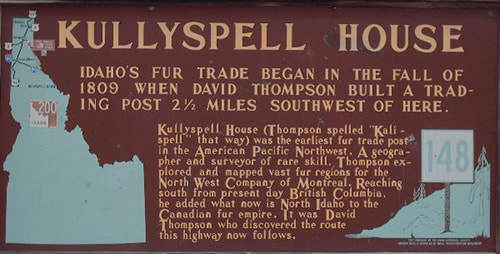
The trading post, called Kullyspell House, was located near present day Hope, about 16 miles from Sandpoint. The historical marker is on Idaho 200 at about mile marker 48.
It was made of split logs and had two big stone chimneys. It was the chimneys that lasted the longest. For 87 years they stood like tombstones against the elements before finally toppling in a big windstorm. With the chimneys fallen, Kullyspell House all but vanished.
In time, even the locals forgot its exact location.
Then in 1928 a group of Idaho pioneers and historians set out to settle the question of just where Kullyspell House had been located. Ironically, they used a blind man as their guide. An aged Indian named Kali Too remembered seeing the chimneys as a child. Even though Kali Too had been blind for many years he remembered the landscape clearly. He told the group to go to a certain point along the shore of Lake Pend Oreille. From there, he told them to look for a big rock that was shaped like a bear's paw. Sure enough, when they got to the site there was a rock that looked like a bear's paw. From there the old Indian directed the party inland. In just a few minutes a cheer went up. They had found a pile of rocks that might once have been the missing chimneys. Later archaeological research proved it. Kullyspell House--or what was left of it--had been found. You might call it blind luck.

Published on January 24, 2023 04:00
January 23, 2023
Indian Rocks State Park (tap to read)
Several parks have come and gone over the 115-year history of state parks in Idaho. One you might remember is Indian Rocks State Park. The Idaho Department of Parks and Recreation (technically the Idaho Department of Parks at the time) acquired 3,000 acres south of Pocatello from the US Bureau of Land Management in 1968 through the Federal Recreation and Public Purposes Act for $2.50 an acre. The Indian Rocks State Park visitor center was located on the west side of I-15 at the exit to Lava Hot Springs.
Park planners hoped campers would stop on their way to Yellowstone National Park. They also hoped a planned reservoir nearby would attract boaters and fishermen. The US Army Corps of Engineers decided there was not enough public support for building a reservoir on nearby Marsh Creek. The park closed in 1983 during a state budget crisis, and it never reopened.
 The visitor center at Indian Rocks State Park.
The visitor center at Indian Rocks State Park.
Park planners hoped campers would stop on their way to Yellowstone National Park. They also hoped a planned reservoir nearby would attract boaters and fishermen. The US Army Corps of Engineers decided there was not enough public support for building a reservoir on nearby Marsh Creek. The park closed in 1983 during a state budget crisis, and it never reopened.
 The visitor center at Indian Rocks State Park.
The visitor center at Indian Rocks State Park.
Published on January 23, 2023 04:00
January 22, 2023
Idaho Hot Spot (tap to read)
What do you think of when you hear the term “Idaho hot spot?” Maybe a new restaurant or trendy bar? Not nearly as hot as the subject of today’s post.
If you look at a topographic map of Idaho you can’t help but notice the swoop of the Snake River as it moves east to west through the southern part of the state. That’s called the Snake River Plain. It would be natural to assume that the Snake River created it, perhaps as it meandered back and forth through geologic time. That assumption would be wrong. The Snake River Plain was created by a lot of geological forces, including water erosion, but it’s primarily a signature left behind by a hot spot beneath the earth’s crust.
The crust of the earth is moving west in relation to this hot spot, so its impact is moving east. Think of the hot spot as being stationary while the crust moves west. In the illustration you can see where the hot spot was 16 million years ago along the Oregon/Nevada border. As the crust continued west, the stationary hot spot effectively move east. It “entered” the state some 15 million years ago, was somewhere around Bruneau Dunes about 12 million years ago, and was parked under Craters of the Moon National Monument about 7 to 10 million years ago.
As the hot spot moved, it produced a lot of volcanic activity on the surface. The Craters area is one visible indication of this. The area known as Island Park is where the hot spot made a big showing about 5 million years ago. It left behind a couple of calderas, or collapsed volcanoes. The Henry’s Fork Caldera is between 18 and 23 miles across. That’s huge. Still, it comfortably fits INSIDE the Island Park Caldera, which is 50 to 65 miles wide. Upper Mesa Falls is where the water of the Henrys Fork splashes over the edge of the old volcano.
So, has the hot spot gone away? Nope. You can find it today under Yellowstone National Park heating up the geysers and hot pools and causing social media to come unglued whenever there is swarm of earthquakes.
By the way, this is the same thing that’s going on with the Hawaiian Islands. That hot spot acts of as the earth’s crust moves over the top of it, too. Since there is no land mass the resulting volcanic activity produces islands. One of the oldest islands, Kauai, is to the furthest west. As that hot spot moved—in relation to the crust—east, it created Oahu, Maui, and then the Big Island, Hawaii. That’s where the volcanic activity is today.
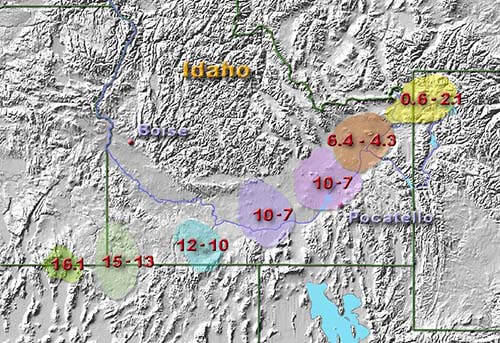 Past locations of the hot spot in millions of years. The illustration is courtesy of Kelvin Case at English Wikipedia.
Past locations of the hot spot in millions of years. The illustration is courtesy of Kelvin Case at English Wikipedia.
If you look at a topographic map of Idaho you can’t help but notice the swoop of the Snake River as it moves east to west through the southern part of the state. That’s called the Snake River Plain. It would be natural to assume that the Snake River created it, perhaps as it meandered back and forth through geologic time. That assumption would be wrong. The Snake River Plain was created by a lot of geological forces, including water erosion, but it’s primarily a signature left behind by a hot spot beneath the earth’s crust.
The crust of the earth is moving west in relation to this hot spot, so its impact is moving east. Think of the hot spot as being stationary while the crust moves west. In the illustration you can see where the hot spot was 16 million years ago along the Oregon/Nevada border. As the crust continued west, the stationary hot spot effectively move east. It “entered” the state some 15 million years ago, was somewhere around Bruneau Dunes about 12 million years ago, and was parked under Craters of the Moon National Monument about 7 to 10 million years ago.
As the hot spot moved, it produced a lot of volcanic activity on the surface. The Craters area is one visible indication of this. The area known as Island Park is where the hot spot made a big showing about 5 million years ago. It left behind a couple of calderas, or collapsed volcanoes. The Henry’s Fork Caldera is between 18 and 23 miles across. That’s huge. Still, it comfortably fits INSIDE the Island Park Caldera, which is 50 to 65 miles wide. Upper Mesa Falls is where the water of the Henrys Fork splashes over the edge of the old volcano.
So, has the hot spot gone away? Nope. You can find it today under Yellowstone National Park heating up the geysers and hot pools and causing social media to come unglued whenever there is swarm of earthquakes.
By the way, this is the same thing that’s going on with the Hawaiian Islands. That hot spot acts of as the earth’s crust moves over the top of it, too. Since there is no land mass the resulting volcanic activity produces islands. One of the oldest islands, Kauai, is to the furthest west. As that hot spot moved—in relation to the crust—east, it created Oahu, Maui, and then the Big Island, Hawaii. That’s where the volcanic activity is today.
 Past locations of the hot spot in millions of years. The illustration is courtesy of Kelvin Case at English Wikipedia.
Past locations of the hot spot in millions of years. The illustration is courtesy of Kelvin Case at English Wikipedia.
Published on January 22, 2023 04:00
January 21, 2023
A Persistent Philanthropist (tap to read)
Virgil McCroskey might have been Idaho’s most persistent philanthropist, even though he didn’t live here. Virgil’s parents homesteaded near Steptoe Butte, about eight miles from Colfax, Washington. Virgil played there as a child and grew to love the views of the Palouse from its summit. As an adult his vocation was pharmacist, and his avocation was conservationist. He donated Steptoe Butte to the State of Washington in 1945 to create Steptoe Butte State Park.
He also loved the views of the Palouse just across the border in Idaho from the ridgetops along a winding dirt road called Skyline Drive. He began buying up property there so that he could present Idaho with a state park.
When Virgil McCroskey approached the Idaho Legislature in 1951 about accepting his gift of land, legislators worried about upkeep and about taking 2,000 acres off the property tax rolls. McCroskey purchased more property to add to the gift. By 1954, he had 4,400 acres to offer and a new governor, Robert E. Smylie, as a supporter. Still the legislators were concerned about maintenance, so McCroskey, 79 years old, agreed to maintain it himself for the next 15 years. The lawmakers finally relented, accepting the gift. McCroskey kept his word, taking care of the site until just before his death at age 94 in 1970.
In a sense, he still cares for the park today. McCroskey left $45,000 in trust to the state to be used for maintenance of Mary Minerva McCroskey State Park, which is named for his mother in honor of the pioneer women of the West.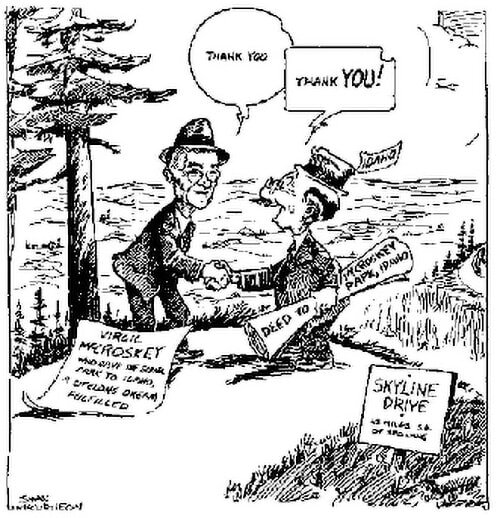
He also loved the views of the Palouse just across the border in Idaho from the ridgetops along a winding dirt road called Skyline Drive. He began buying up property there so that he could present Idaho with a state park.
When Virgil McCroskey approached the Idaho Legislature in 1951 about accepting his gift of land, legislators worried about upkeep and about taking 2,000 acres off the property tax rolls. McCroskey purchased more property to add to the gift. By 1954, he had 4,400 acres to offer and a new governor, Robert E. Smylie, as a supporter. Still the legislators were concerned about maintenance, so McCroskey, 79 years old, agreed to maintain it himself for the next 15 years. The lawmakers finally relented, accepting the gift. McCroskey kept his word, taking care of the site until just before his death at age 94 in 1970.
In a sense, he still cares for the park today. McCroskey left $45,000 in trust to the state to be used for maintenance of Mary Minerva McCroskey State Park, which is named for his mother in honor of the pioneer women of the West.

Published on January 21, 2023 04:00
January 20, 2023
Benedicte Wrensted (tap to read)
Benedicte Wrensted was a photographer when female photographers were rare. She had a studio in Pocatello from 1895 to 1912. Her interest in taking pictures of the residents of the nearby Fort Hall Indian Reservation went largely unremarked in her time. Those she took pictures of treasured them and took them home to display.
It wasn’t until 1984 that her work began to come to light when anthropologist Joanna Coan Scherer discovered a collection of negatives at the National Archives labled,
“Portraits of Indians from Sotheastern Idaho Resevations, 1897.” In Scherer’s opinion the portraits were remarkable for their compelling depiction of the humanity of the photographers subjects. Later, Scherer connected the negatives to Wrensted through a collection of photographs housed at the Bannock County Historical Society.
You can learn more about Wrensted through the website Benedicte Wrenstead: An Idaho Photographer in Focus. She was also feature, along with photographer Jane Gay, in the Idaho Public Television program Out of the Shadows. A Wrensted photo of a Shoshone girl circa 1897.
A Wrensted photo of a Shoshone girl circa 1897.  Left to right: Sonnip or Pohaipe family member, James Edmo, and Jack Edmo. Taken about 1901 by Benedicte Wrensted.
Left to right: Sonnip or Pohaipe family member, James Edmo, and Jack Edmo. Taken about 1901 by Benedicte Wrensted.  These are before and after photos of Pat Tyhee taken by Wrensted. The before shot shows him in native clothing. The after shows Tyhee with a new suit of clothes and a haircut.
These are before and after photos of Pat Tyhee taken by Wrensted. The before shot shows him in native clothing. The after shows Tyhee with a new suit of clothes and a haircut.  Portrait by Benedicte Wrensted of Pohene and Frank George, Lemhi Shoshone and Northern Shoshone (ca. 1897)
Portrait by Benedicte Wrensted of Pohene and Frank George, Lemhi Shoshone and Northern Shoshone (ca. 1897) 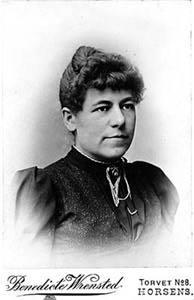 Benedicte Wrensted (1859-1949), a native of Denmark, arrived in the United States in 1894. She was a professional photographer in Pocatello, Idaho from 1895 to 1912.
Benedicte Wrensted (1859-1949), a native of Denmark, arrived in the United States in 1894. She was a professional photographer in Pocatello, Idaho from 1895 to 1912.
It wasn’t until 1984 that her work began to come to light when anthropologist Joanna Coan Scherer discovered a collection of negatives at the National Archives labled,
“Portraits of Indians from Sotheastern Idaho Resevations, 1897.” In Scherer’s opinion the portraits were remarkable for their compelling depiction of the humanity of the photographers subjects. Later, Scherer connected the negatives to Wrensted through a collection of photographs housed at the Bannock County Historical Society.
You can learn more about Wrensted through the website Benedicte Wrenstead: An Idaho Photographer in Focus. She was also feature, along with photographer Jane Gay, in the Idaho Public Television program Out of the Shadows.
 A Wrensted photo of a Shoshone girl circa 1897.
A Wrensted photo of a Shoshone girl circa 1897.  Left to right: Sonnip or Pohaipe family member, James Edmo, and Jack Edmo. Taken about 1901 by Benedicte Wrensted.
Left to right: Sonnip or Pohaipe family member, James Edmo, and Jack Edmo. Taken about 1901 by Benedicte Wrensted.  These are before and after photos of Pat Tyhee taken by Wrensted. The before shot shows him in native clothing. The after shows Tyhee with a new suit of clothes and a haircut.
These are before and after photos of Pat Tyhee taken by Wrensted. The before shot shows him in native clothing. The after shows Tyhee with a new suit of clothes and a haircut.  Portrait by Benedicte Wrensted of Pohene and Frank George, Lemhi Shoshone and Northern Shoshone (ca. 1897)
Portrait by Benedicte Wrensted of Pohene and Frank George, Lemhi Shoshone and Northern Shoshone (ca. 1897)  Benedicte Wrensted (1859-1949), a native of Denmark, arrived in the United States in 1894. She was a professional photographer in Pocatello, Idaho from 1895 to 1912.
Benedicte Wrensted (1859-1949), a native of Denmark, arrived in the United States in 1894. She was a professional photographer in Pocatello, Idaho from 1895 to 1912.
Published on January 20, 2023 04:00
January 19, 2023
A Political Family (tap to read)
Today, we’re going to take a quick look at a family that has been a major force in Idaho politics.
We’ll start with John W. Thomas. Thomas is not the best-known US Senator ever to come from the State of Idaho, but he was one of the more persistent people to hold a Senate seat. His first taste of politics was as the mayor of Gooding. From 1925-1933, he was a member of the Republican National Committee. Thomas became a senator the first time in 1928, not by election, but by appointment when Sen. Frank Gooding died in office. He won a special election later that year, and served until 1933. He had lost a reelection bid to Democrat James Pope in 1932.
Thomas became a senator again in 1940, when he was appointed to fill the seat of William Borah, perhaps Idaho’s most famous senator. He was elected to the seat in 1942, but died in office three years later.
The political lineage of the family continues with Thomas’ daughter, Mary. She married Art Peavey of Twin Falls when both were students at the University of Idaho. They had two children, John and Elizabeth (Betty). Mary was widowed when Art Peavey was lost in a boating accident on the Snake River in 1941. She would marry C. Wayland “Curly” Brooks, a US Senator from Illinois in 1946. They were married eleven years until his death from a heart attack in 1957.
Mary Brooks ran her father’s sheep ranch in Idaho from 1945 until 1961, when her son John took over. She served in the Idaho Senate from 1963 until 1969. It was in 1969 that President Nixon tapped Mary Brooks to run the US Mint, a post she held until February 1977. The photo is of Mary Brooks with President Nixon celebrating the release of the Eisenhower dollar.
It is Mary’s son, John Peavey, who is likely most familiar to Idahoans today, if only because he was in politics more recently. Peavey was appointed to fill his mother’s seat when she became Director of the Mint. He served in the Idaho Senate for 23 years, and ran unsuccessfully for lieutenant governor in 1994.
 Mary Brooks in a room full of gold at the U.S. Mint.
Mary Brooks in a room full of gold at the U.S. Mint.
We’ll start with John W. Thomas. Thomas is not the best-known US Senator ever to come from the State of Idaho, but he was one of the more persistent people to hold a Senate seat. His first taste of politics was as the mayor of Gooding. From 1925-1933, he was a member of the Republican National Committee. Thomas became a senator the first time in 1928, not by election, but by appointment when Sen. Frank Gooding died in office. He won a special election later that year, and served until 1933. He had lost a reelection bid to Democrat James Pope in 1932.
Thomas became a senator again in 1940, when he was appointed to fill the seat of William Borah, perhaps Idaho’s most famous senator. He was elected to the seat in 1942, but died in office three years later.
The political lineage of the family continues with Thomas’ daughter, Mary. She married Art Peavey of Twin Falls when both were students at the University of Idaho. They had two children, John and Elizabeth (Betty). Mary was widowed when Art Peavey was lost in a boating accident on the Snake River in 1941. She would marry C. Wayland “Curly” Brooks, a US Senator from Illinois in 1946. They were married eleven years until his death from a heart attack in 1957.
Mary Brooks ran her father’s sheep ranch in Idaho from 1945 until 1961, when her son John took over. She served in the Idaho Senate from 1963 until 1969. It was in 1969 that President Nixon tapped Mary Brooks to run the US Mint, a post she held until February 1977. The photo is of Mary Brooks with President Nixon celebrating the release of the Eisenhower dollar.
It is Mary’s son, John Peavey, who is likely most familiar to Idahoans today, if only because he was in politics more recently. Peavey was appointed to fill his mother’s seat when she became Director of the Mint. He served in the Idaho Senate for 23 years, and ran unsuccessfully for lieutenant governor in 1994.
 Mary Brooks in a room full of gold at the U.S. Mint.
Mary Brooks in a room full of gold at the U.S. Mint.
Published on January 19, 2023 04:00
January 18, 2023
Deep Throat (tap to read)
Today we have the story of an Idahoan who was more famous by his code name than his real name.
Mark Felt was born in Twin Falls, Idaho in 1913. He went to Twin Falls High School, and graduated from the University of Idaho in 1935. In 1938 Felt married a girl from Gooding, Audrey Robinson.
Felt went to work for U.S. Senator from Idaho James P. Pope, and later worked for his successor David Worth Clark.
Going to school nights, Felt earned a law degree from George Washington University, graduating in 1940. He started a career with the FBI in 1941, working his way up to the second highest spot in the bureau, associate director in 1972, retiring in 1973.
Oh, and he was “Deep Throat.”
Bob Woodward and Carl Bernstein of The Washington Post , depended heavily on his anonymous tips during the Watergate scandal that brought down President Richard Nixon.
Only a handful of people (including Nixon) knew who “Deep Throat” was, until Vanity Fair magazine revealed the secret on May 31, 2005, when it published an article on its website, followed up by an article in the magazine’s June edition (photo).
Mark Felt passed away December 18, 2008 at the age of 95.
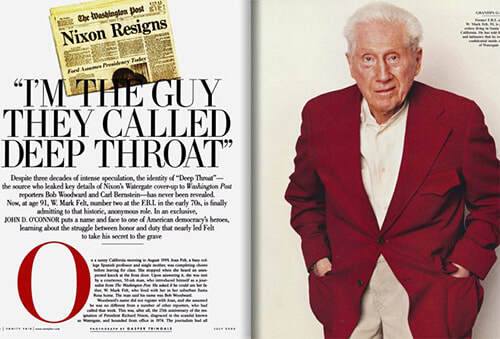
Mark Felt was born in Twin Falls, Idaho in 1913. He went to Twin Falls High School, and graduated from the University of Idaho in 1935. In 1938 Felt married a girl from Gooding, Audrey Robinson.
Felt went to work for U.S. Senator from Idaho James P. Pope, and later worked for his successor David Worth Clark.
Going to school nights, Felt earned a law degree from George Washington University, graduating in 1940. He started a career with the FBI in 1941, working his way up to the second highest spot in the bureau, associate director in 1972, retiring in 1973.
Oh, and he was “Deep Throat.”
Bob Woodward and Carl Bernstein of The Washington Post , depended heavily on his anonymous tips during the Watergate scandal that brought down President Richard Nixon.
Only a handful of people (including Nixon) knew who “Deep Throat” was, until Vanity Fair magazine revealed the secret on May 31, 2005, when it published an article on its website, followed up by an article in the magazine’s June edition (photo).
Mark Felt passed away December 18, 2008 at the age of 95.

Published on January 18, 2023 04:00
January 17, 2023
Little Jo (tap to read)
Have you ever fantasized about starting a new life? Perhaps no one ever did that more completely than Little Jo Monaghan.
Jo showed up in Ruby City, Idaho Territory in 1867 or 1868 determined to try his hand at mining. He was a slight little guy, no more than five feet tall, but he was a real worker. He dug with the best of them for several weeks, then decided mining was just too tough.
Jo Monaghan then became a sheepherder, spending three years mostly in the company of sheep. After that, he worked in a livery for a time and took to breaking horses for a living. He was so good at it that Andrew Whalen hired him to work in Whalen’s Wild West Show, billing the bronc rider as Cowboy Joe. Whalen offered $25 to anyone who could find a horse the man couldn’t ride.
Eventually Jo homesteaded near Rockville, Idaho. He built a cabin and raised a few livestock, living a quiet life. He served on juries and voted in elections. Jo Monaghan was a respected member of the community. A quiet man. Except that he wasn’t
In 1904 Jo Monaghan passed away. The Weiser Signal marked Jo’s death with the headline, "Sex is Discovered After Death" and noted that, "There are a number of people residing in Weiser, who knew the supposed man intimately, and never had a suspicion that she was not what she represented to be."
Jo Monaghan was a woman. Who that woman was is still open to speculation. One story often told is that she was from a wealthy New York family and had found herself in a family way. As that story goes, she left her child for her sister to raise and headed West. It wasn’t uncommon for women at that time to travel as men to help assure their own safety. Jo may have done that and simply found it convenient to keep up the ruse.
The story has fascinated people for decades. A 1993 movie called The Ballad of Little Joe, written and directed by Maggie Greenwald and starring Suzy Amis as Jo told a version of her life.
The part of the story that always interested me was that he voted. No, make that SHE voted. She might have been one of the first women to cast a vote in the United States.

Jo showed up in Ruby City, Idaho Territory in 1867 or 1868 determined to try his hand at mining. He was a slight little guy, no more than five feet tall, but he was a real worker. He dug with the best of them for several weeks, then decided mining was just too tough.
Jo Monaghan then became a sheepherder, spending three years mostly in the company of sheep. After that, he worked in a livery for a time and took to breaking horses for a living. He was so good at it that Andrew Whalen hired him to work in Whalen’s Wild West Show, billing the bronc rider as Cowboy Joe. Whalen offered $25 to anyone who could find a horse the man couldn’t ride.
Eventually Jo homesteaded near Rockville, Idaho. He built a cabin and raised a few livestock, living a quiet life. He served on juries and voted in elections. Jo Monaghan was a respected member of the community. A quiet man. Except that he wasn’t
In 1904 Jo Monaghan passed away. The Weiser Signal marked Jo’s death with the headline, "Sex is Discovered After Death" and noted that, "There are a number of people residing in Weiser, who knew the supposed man intimately, and never had a suspicion that she was not what she represented to be."
Jo Monaghan was a woman. Who that woman was is still open to speculation. One story often told is that she was from a wealthy New York family and had found herself in a family way. As that story goes, she left her child for her sister to raise and headed West. It wasn’t uncommon for women at that time to travel as men to help assure their own safety. Jo may have done that and simply found it convenient to keep up the ruse.
The story has fascinated people for decades. A 1993 movie called The Ballad of Little Joe, written and directed by Maggie Greenwald and starring Suzy Amis as Jo told a version of her life.
The part of the story that always interested me was that he voted. No, make that SHE voted. She might have been one of the first women to cast a vote in the United States.

Published on January 17, 2023 04:00



